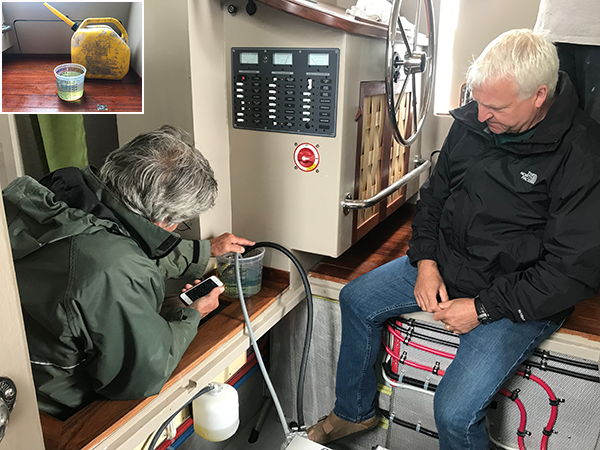Fuel Efficiency - Results of Fuel Efficiency Trial - June 2022
[June 2022] The discovery that during her first season 38’ Cape Sable Stanley burned less than half a (US) gallon/hour (see below) has led to a commitment for careful readings at various rpms/speeds this season.
In a world where 2 US gallons/hr at 8 knots is considered excellent, the first test continued to show that the Cape Sable design is one of the most fuel-efficient live-aboard trawlers currently being built.
For a boat designed for cruising the ocean in comfort and safety, fuel-efficiency is a wonderful bonus.

The first trials were done with the boat cruising up the LaHave River between East LaHave and Dayspring on June 8 one hour before the top of the tide so with minimal current running against the boat with the following results:
At 1600 rpm cruising at 6.5 knots Stanley’s Yanmar 4JH110 engine burned 0.45 liters in ten minutes. For a full hour the fuel consumption would be: 2.7 liters/hr or 0.71 gph or 0.59 Imp. gph. Or 9.15 nautical miles per US gallon or 10.7 miles/Imperial gallon.
At 2000 rpm cruising at 8 knots the Cape Sable prototype burned 0.8 liters in ten minutes. The hour equivalents: 4.8 liters/hr or 1.26 gph or 1.055 Imp. gph. Or 6.36 nautical miles per US gallon or 7.58 nautical miles/Imperial gallon.
The 1.26 gph figure for the 8 knots trial is slightly better than what Yanmar expects for this engine, according to the graph in the left column of this web page.
For this test the engine drew fuel directly from a calibrated container and the fuel level was observed immediately before and after each run.
(Although it’s unlikely a long-range cruiser would run at 2400 rpm, a five-minute test was included at approx. 10 knots. Consumption: 0.95 liters. The hour equivalents: 11.4 liters/hr or 3.01 gph or 2.5 Imp. gph.)
The trial was witnessed by Canadian Coast Guard Captain Rodney Strowbridge who has confirmed this report as “accurate to what I witnessed.” (tstrowbridge@eastlink.ca). Capt. Strowbridge was on leave from his duties at the helm of the icebreaker Kopit Hopson 1752.
Further testing may include downriver cruising as well as moving against the current.
Contact Cape Sable co-designer John Steele to discuss these results: john@capeislandcruisers.com .
